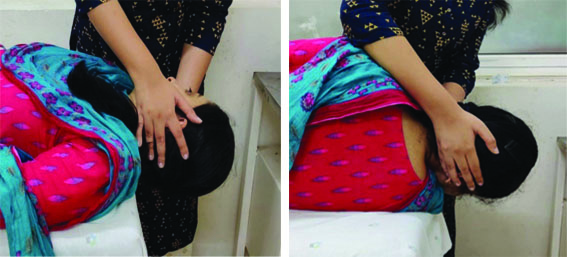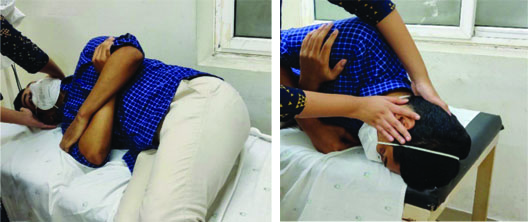The BPPV is the most common cause of vertigo in otorhinolaryngological practice. The cause for vertigo in BPPV is due to dysfunction of labyrinth. The BPPV was initially described by Barany in 1921 [1]. The BPPV is characterised by episodic attacks of vertigo, associated with nystagmus. The BPPV aggravates due to change in head posture with respect to gravity. There are different types of BPPV based on the canal involvement. They are classified accordingly:
The aim and objective of the study was to compare the effectiveness of Epley’s and Semont’s maneuver in the treatment of PSC BPPV.
Materials and Methods
A cohort study was conducted in Otorhinolaryngology Department of Chettinad Hospital and Research Institute, Chennai, Tamil Nadu from October 2020 to March 2021. Institutional Human Ethics Committee approval (94/IHEC/August 2020) was obtained and written informed consent was obtained from the patients.
Inclusion criteria: A total of 108 cases, of all age groups and either gender for the period of October 2020 to March 2021, who presented to outpatient department and were diagnosed with PSC BPPV were included in this study.
Exclusion criteria: Patients with any inner ear pathology causing vertigo such as Meniere disease, labyrinthitis, vestibulitis, petrositis, vestibular neuronitis and central causes of vertigo were excluded.
Study Procedure
A detailed clinical history was recorded, audio vestibular examination and Dix-Hallpike maneuver were performed to confirm the diagnosis. Clinical examinations to rule out any central causes of vertigo were performed. Following which, patients who were diagnosed as PSC BPPV were subjected to treatment with either Epley’s maneuver or Semont’s maneuver. Patients were randomly allocated into two groups. One group treated with Epley’s and another group treated with Semont’s maneuver. Patients were followed-up one week after performing the maneuver. In case of presence of persistent symptoms, maneuver was repeated upto a maximum of three times. Treatment was said to be successful based upon the patient’s symptomatic improvement of vertigo and a negative Dix-Hallpike test which was performed at the first follow-up (one week after the treatment) in outpatient department. In Dix-Hallpike test, the patient was made to sit and their head was turned 45° towards the affected side. Then the patient was made to lie down rapidly in supine position and their neck was extended to 20° with the affected ear facing downwards. The patient should be observed for vertigo and nystagmus. A positive response is elicited if nystagmus was observed [6]. The patients with positive response were subjected to further management.
Epley’s maneuver: In this method, was made to sit and the head was rotated 45o towards the affected side. The patient was then rapidly made to lie down in a supine position with the affected ear down (similar to the part of the Dix-Hallpike test). The neck was supported and extended approximately 20°. Following this, patient will have vertigo and/or nystagmus. The patient was maintained in the same position till these symptoms subsided. Then the head was turned towards the opposite side approximately 90° so that the normal ear faced down and head was maintained in the same position for 30 seconds. The patient’s body was rolled in the same direction by 90° along with head so that the patient would be facing downwards and this position was maintained for another 30 seconds. The patient was finally brought up to the sitting position with the head still turned 45° to the unaffected side. The entire procedure of changing in head position was done slowly [Table/Fig-1].

Semont’s maneuver: In this method, the patient was made to sit and the head was turned towards the unaffected side and he/she was made to lie rapidly towards the affected side, with the head turned in upward direction. The patient was maintained in this position for five minutes following which he/she was moved quickly through the sitting position to the lying position on the opposite side with the head facing downward and this position was maintained for 5-10 minutes. After which he/she was brought back to the sitting position slowly [Table/Fig-2].

General instructions like head end elevation to 30° during sleep, to avoid sudden a change in head posture and to avoid lying on their affected side for five days were given to the patients. All drugs for treatment of vertigo were stopped.
Statistical Analysis
Data was analysed using Statistical Package for Social Sciences (SPSS) version 19. Data was presented in proportion (Descriptive statistics) and chi-square test was used. The p-value <0.05 was considered as statistically significant.
Results
In a total of 108 cases, the most common age group affected by BPPV was 21-40 years (46 cases) followed by the age group of 41-60 years (43 cases). The mean age of the patient in years was 26.5±14.8 in epleys and 29.3±13.5 in semonts maneuver. Out of 108 cases, 51 patients were male and 57 patients were female. About 13 (12%) patients with BPPV were found to have diabetes mellitus though the cause for BPPV was mostly idiopathic [Table/Fig-3].
Demographic information of subjects.
| Variables | Epley’s Maneuver n (%) | Semont’s Maneuver n (%) | Total (N) | p-value |
|---|
| Age group |
| ≤20 years | 4 (7.4) | 3 (5.6) | 7 (6.5) | 0.7663 |
| 21-40 years | 24 (44.4) | 22 (40.7) | 46 (42.6) |
| 41-60 years | 19 (35.2) | 24 (44.4) | 43 (39.8) |
| > 60 years | 7 (13) | 5 (9.3) | 12 (11.1) |
| Gender |
| Male | 25 (46.3) | 26 (48.1) | 51 (47.2) | 0.8471 |
| Female | 29 (53.7) | 28 (51.9) | 57 (52.8) |
| Co-morbidities |
| Diabetes mellitus | 7 (13) | 6 (11.1) | 13 (12) | 0.9549 |
| Hypertension | 5 (9.3) | 5 (9.3) | 10 (9.3) |
| CAD | 3 (5.5) | 2 (3.7) | 5 (4.6) |
| None | 39 (72.2) | 41 (75.9) | 80 (74.1) |
Chi-square test; n=54 in each group; CAD: Coronary artery disease
Audiological tests were performed and 58 (53.7%) patients had normal hearing sensitivity. Presbycusis were seen in 44 (40.7%) patients [Table/Fig-4].
| Variables | Epley’s Maneuver n (%) | Semont’s Maneuver n (%) | Total (N) | p-value |
|---|
| Audiology |
| Moderate CHL | 2 (3.7) | 1 (1.8) | 3 (2.8) | 0.8431 |
| Mild CHL | 1 (1.8) | 2 (3.7) | 3 (2.8) |
| Presbycusis | 23 (42.6) | 21 (38.9) | 44 (40.7) |
| Normal | 28 (51.9) | 30 (55.6) | 58 (53.7) |
| Laterality |
| Left | 25 (46.3) | 25 (46.3) | 50 (46.3) | 0.7853 |
| Right | 23 (42.6) | 25 (46.3) | 48 (44.4) |
| Bilateral | 6 (11.1) | 4 (7.4) | 10 (9.3) |
CHL: Conductive hearing loss; Chi-square test
A total of 52 (96.3%) patients responded well to Epley’s maneuver and had complete resolution of symptoms on first follow-up (after one week of first visit of the patient). Remaining two patients who failed to respond to Epley’s maneuver in the first follow-up, showed improvement in the second follow-up (after two weeks of first visit of the patient). Out of 54 patients, 46 (85.2%) patients responded to Semont’s maneuver and improved symptomatically [Table/Fig-5]. Among eight patients who failed to respond to Semont’s maneuver in the first follow-up, three patients improved symptomatically in the second follow-up and five patients showed improvement in the third follow-up (after five weeks of first visit of the patient).
| Variables | Epley’s Maneuver n (%) | Semont’s Maneuver n (%) | Total (N) | p-value |
|---|
| Recurrence |
| Present | 2 (3.7) | 8 (14.8) | 10 (9.3) | 0.0464* |
| Absent | 52 (96.3) | 46 (85.2) | 98 (90.7) |
Chi-square test; *Significant
After initiation of maneuvers for treatment for BPPV, six subjects presented with nausea, four subjects had vomiting and 11 of them had giddiness. Though between the two Maneuvers, Epley’s was better tolerated by patients, the difference was not statistically significant [Table/Fig-6].
Symptoms after initiation of maneuver.
| Symptoms | Epley’s Maneuver n (%) | Semont’s Maneuver n (%) | Total | p-value |
|---|
| Nausea | 2 (3.7) | 4 (7.4) | 6 (5.5) | 0.3842 |
| Vomiting | 1 (1.9) | 3 (5.5) | 4 (3.7) |
| Giddiness | 4 (7.4) | 7 (13) | 11 (10.2) |
| None | 47 (87) | 40 (74.1) | 87 (80.6) |
Chi-square test
Discussion
Among 108 cases in this study, about 46 patients affected by BPPV were in the age group of 21-40 years. About 13 BPPV patients were found to be diabetic in our study. But co-morbid conditions such as diabetes, hypertension, mild head injury and sinusitis are not usually common in BPPV patients [7]. Prathap M et al., reported that BPPV was mostly commonly seen in age group of 41-60 years in female patients [1]. In most cases, he observed laterality towards the right side and found BPPV was associated with hypertension as majority of BPPV patients had hypertension. According to Prathap M et al., Epley’s maneuver was found to be a successful and effective procedure in the management of idiopathic BPPV and thus the findings of Prathap M et al., was in agreement with this study [1]. There was a multicentre observational study stating that co-morbidities can cause recurrent episodes of BPPV and as co-morbidity disorders increased the number of relapses increased too [8]. In this study, 57 females and 51 males were affected by BPPV. Female predominance was seen which was consistent with other studies [9,10].
Lee JD et al., concluded with significant results that the Epley’s maneuver was more effective than the Semont’s or sham maneuvers for the treatment of posterior canal BPPV [11]. Gupta AK et al., correlated the results of VAP score and Dix-Hallpike and finally stated that Epley’s maneuver has given good result in patients when compared to Semont’s maneuver [12]. Liu Y et al., found that the Epley’s maneuver is safer and more effective in the short term treatment of BPPV of PSC and has a similar outcome to the Semont’s maneuver [13]. Mazoor T and Niazi SB suggested that the most common cause for peripheral vertigo is BPPV and both Epley’s and Semont’s maneuvers are equally effective and helpful in faster recovery of the patients [14]. Acharya S et al., in his observational prospective study, stated that both the maneuvers were effective in the management of BPPV but Epley’s maneuver was superior to Semont’s maneuver in terms of remission of symptoms [15]. Ajayan PV et al., suggested that Epley’s and Semont’s maneuver were equally effective in the management of posterior canal BPPV [16]. Sen K et al., concluded that BPPV is one of the most common causes of peripheral vertigo and also stated that Epley’s maneuver was more effective than Semont’s maneuver in the treatment of BPPV [17]. Thus, the results of the above study are in agreement with the results of the present study. For management of BPPV, Epley’s maneuver is an effective modality [18]. There is positive impact on the quality of life for patients treated with Epley’s maneuver [19].
Limitation(s)
The limitations of the study were lack of long term follow-up and lack of assessment of aetiology. No potential bias was identified in the present study.
Conclusion(s)
The present study demonstrated that canalith repositioning and liberatory maneuvers had effective role in the management of PSC BPPV. Majority of the patients got benefited from the treatment and very less number of patients had a recurrence. Patients improved symptomatically in the first visit itself with Epley’s maneuver compared to Semont’s maneuver. Hence Epley’s maneuver is the preferred initial treatment and effective treatment modality for PSC BPPV.
Chi-square test; n=54 in each group; CAD: Coronary artery disease
CHL: Conductive hearing loss; Chi-square test
Chi-square test; *Significant
Chi-square test